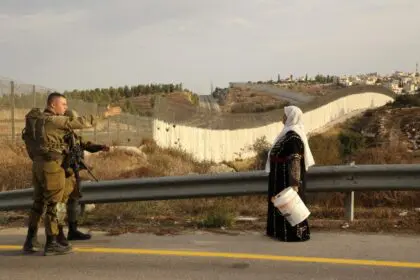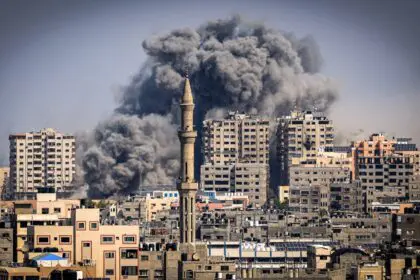In Bethlehem, Israeli settlement expansion and land grab has shrunk the city to less than 13% of its original size.

Nour Odeh
Following unanimous outrage from Churches in Jerusalem, Israel nixed plans to expand a national park onto church-owned lands and Christian holy sites in occupied East Jerusalem. End of story? Not quite.
While Israeli National Parks are presented as part of the country’s “green” policies, to Palestinians, Christians and Muslims, they are a constant reminder of the ongoing takeover of their land in the Occupied Palestinian Territory and within Israel’s recognized borders. For Palestinian Christians, the issue is critical. They have long voiced their concerns that Israeli policies are emptying Palestine of the world’s original Christians. They charge that such moves are nothing more than a continuation of Israel’s systematic push to grab Palestinian land and erase Palestinian Christians from the landscape, which started with the Nakba.
The systemic ethnic cleansing of Palestinians at the hands of Zionist militias between 1947 and 1949, known as the Nakba (Catastrophe), was especially devastating to Palestinian Christians and their presence in Palestine, with roughly 35% turned into refugees while others became internally displaced. This targeting of Palestinian Christians altered the Palestinian social fabric and deprived Palestine of important social, educational, political, and business actors that had an indelible mark on society prior to the Nakba.
This devastation did not stop with the creation of Israel in 1948. For Palestinians, Christian Palestinians included, the Nakba continues. The displacement and silent transfer of Palestinian Christians has diminished their numbers to between 1 and 2 percent of the Palestinian population in the Occupied Palestinian Territory, including Jerusalem.
The Israeli organization Ir Amim describes national parks in occupied East Jerusalem as “useful tools in the political-strategic settlement enterprise.” According to the organization, Israel erects and expands national parks in occupied East Jerusalem to “complete and connect settlements in the middle of Palestinian neighborhoods, limit Palestinian use of land, and provide nationalist organizations, into whose hands the parks were privatized, with a firm grasp on the land.”
This policy of land grab by parks extends to the rest of the West Bank, with Israel expropriating thousands of hectares of Palestinian land to establish or expand “parks” that serve illegal Israeli settlements. Nearly 800 km2, or close to 14% of the West Bank territory, has been taken over by this policy.
Seizure of Palestinian Christian land is most acute in Jerusalem, where the number of Palestinian Christians is a fraction of what it was in 1948. According to Archbishop Theodosius Attulah, spokesperson for the Greek Orthodox Church, Christian properties have been a target since the Nakba, with the aim being “marginalizing Palestinian influence and weakening the Christian presence in the Old City.” This is done by a combination of tactics, including land grab, economic strangulation, and shady title transfers of Christian and Church property to the hands of Israeli settler organizations.
The case of the landmark New Imperial and Petra Hotels at the Jaffa Gate in Jerusalem’s Christian Quarters are emblematic of the land grab drive inside the City. The Greek Orthodox Church, Jerusalem’s largest real estate owner, insists that the sale was unauthorized and struck illegally with Ateret Cohanim, a rightwing settler organization dedicated to the “physical and spiritual redemption” of Jerusalem. Still, Israeli courts upheld the dubious sale.
In addition to land grab, Israel has in recent years attempted to financially squeeze Churches in Jerusalem. In 2018, the Israeli municipality in Jerusalem claimed that Churches in Jerusalem owed $186 million in back taxes and confiscated millions of dollars from the Anglican, Armenian, Catholic, and Orthodox Churches, sparking outrage. Churches in Jerusalem issued a strong letter of condemnation, accusing Israel of systemically targeting Churches and Christians with a campaign of abuse to weaken the Christian presence in Jerusalem. Benjamin Netanyahu, Israel’s Prime Minister at the time, stopped the measure and suspended discussion of draft legislation that would have allowed for the confiscation of Church property in lieu of owed tax debt.
In Bethlehem, Israeli settlement expansion and land grab has shrunk the city to less than 13% of its original size, devastating the local economy and creating a coercive environment for local Palestinian Christians. Families and Churches must regularly defend against attempts by Israeli occupation authorities to expropriate their property to serve the expanding illegal wall or the sprawling illegal settlements that choke the area.
A case in point was the Cremisan valley, which was threatened by the Israeli segregation wall. It took years of legal battles launched by 57 Palestinian Christian families and the Catholic Patriarchy, including the local Salesian Sisters of Cremisan, to protect the valley from Israeli expropriation.
Another Church property in the area was not so lucky. The Beit Al-Baraka Church Compound, owned by the US Presbyterian Church, was expropriated through a dubious sale to a shell company in Sweden that transferred ownership to a settler organization. The sale was done without consulting the Church’s branch in Palestine.
Inside Israel, creating national parks served to erase Palestinian villages depopulated by Israel during the Nakba. In fact, nearly half of these villages are now included within the boundaries of national parks, “nature reserves” and Jewish National Fund (JNF) forests and parks. These include the Carmel Coast Forest and the Biria Forest which respectively cover the remains of ‘Ayn Ghazal, Jaba‘, and Sawamir in one and ‘Amuqa, ‘Ayn al-Zaytun, Fir‘im, Mughr al-Khayt, and Qaba‘a in the other.
Meanwhile, many Christian Palestinian Israelis continue to fight for their right to the villages from which they were forcibly displaced, to no avail. The case of Iqrith and Kfar Bir’im in the Galilee are stark examples of how this policy of social engineering and expropriation live on. Residents of both Christian villages were ordered to the leave their homes by Israeli forces around Christmas of 1948, with a promise that they would return in two weeks. Yet these residents, who are now citizens of Israel, continue to be denied that right.
Over the past five decades, residents have persisted in their attempts to reclaim their villages. They renovated the Church in Iqrith and are now able to bury their dead in the village cemetery. They also hold a one-week summer camp each year to keep the memory and story of their village alive.
But justice through Israeli courts continues to be denied. In one of many court rulings on cases filed by the descendants of Iqrith, the Court rejected their petition on the ground that their case was “political.”




